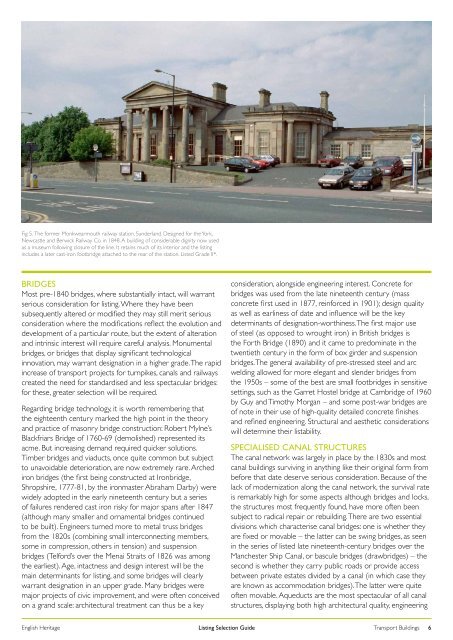Designation Listing Selection Guide: Transport ... - English Heritage
Designation Listing Selection Guide: Transport ... - English Heritage
Designation Listing Selection Guide: Transport ... - English Heritage
Create successful ePaper yourself
Turn your PDF publications into a flip-book with our unique Google optimized e-Paper software.
Fig 5. The former Monkwearmouth railway station, Sunderland. Designed for the York,<br />
Newcastle and Berwick Railway Co. in 1848. A building of considerable dignity now used<br />
as a museum following closure of the line. It retains much of its interior and the listing<br />
includes a later cast-iron footbridge attached to the rear of the station. Listed Grade II*.<br />
BRIDGES<br />
Most pre-1840 bridges, where substantially intact, will warrant<br />
serious consideration for listing. Where they have been<br />
subsequently altered or modified they may still merit serious<br />
consideration where the modifications reflect the evolution and<br />
development of a particular route, but the extent of alteration<br />
and intrinsic interest will require careful analysis. Monumental<br />
bridges, or bridges that display significant technological<br />
innovation, may warrant designation in a higher grade. The rapid<br />
increase of transport projects for turnpikes, canals and railways<br />
created the need for standardised and less spectacular bridges:<br />
for these, greater selection will be required.<br />
Regarding bridge technology, it is worth remembering that<br />
the eighteenth century marked the high point in the theory<br />
and practice of masonry bridge construction: Robert Mylne’s<br />
Blackfriars Bridge of 1760-69 (demolished) represented its<br />
acme. But increasing demand required quicker solutions.<br />
Timber bridges and viaducts, once quite common but subject<br />
to unavoidable deterioration, are now extremely rare. Arched<br />
iron bridges (the first being constructed at Ironbridge,<br />
Shropshire, 1777-81, by the ironmaster Abraham Darby) were<br />
widely adopted in the early nineteenth century but a series<br />
of failures rendered cast iron risky for major spans after 1847<br />
(although many smaller and ornamental bridges continued<br />
to be built). Engineers turned more to metal truss bridges<br />
from the 1820s (combining small interconnecting members,<br />
some in compression, others in tension) and suspension<br />
bridges (Telford’s over the Menai Straits of 1826 was among<br />
the earliest). Age, intactness and design interest will be the<br />
main determinants for listing, and some bridges will clearly<br />
warrant designation in an upper grade. Many bridges were<br />
major projects of civic improvement, and were often conceived<br />
on a grand scale: architectural treatment can thus be a key<br />
consideration, alongside engineering interest. Concrete for<br />
bridges was used from the late nineteenth century (mass<br />
concrete first used in 1877, reinforced in 1901); design quality<br />
as well as earliness of date and influence will be the key<br />
determinants of designation-worthiness. The first major use<br />
of steel (as opposed to wrought iron) in British bridges is<br />
the Forth Bridge (1890) and it came to predominate in the<br />
twentieth century in the form of box girder and suspension<br />
bridges. The general availability of pre-stressed steel and arc<br />
welding allowed for more elegant and slender bridges from<br />
the 1950s – some of the best are small footbridges in sensitive<br />
settings, such as the Garret Hostel bridge at Cambridge of 1960<br />
by Guy and Timothy Morgan – and some post-war bridges are<br />
of note in their use of high-quality detailed concrete finishes<br />
and refined engineering. Structural and aesthetic considerations<br />
will determine their listability.<br />
SPECIALISED CANAL STRUCTURES<br />
The canal network was largely in place by the 1830s and most<br />
canal buildings surviving in anything like their original form from<br />
before that date deserve serious consideration. Because of the<br />
lack of modernization along the canal network, the survival rate<br />
is remarkably high for some aspects although bridges and locks,<br />
the structures most frequently found, have more often been<br />
subject to radical repair or rebuilding. There are two essential<br />
divisions which characterise canal bridges: one is whether they<br />
are fixed or movable – the latter can be swing bridges, as seen<br />
in the series of listed late nineteenth-century bridges over the<br />
Manchester Ship Canal, or bascule bridges (drawbridges) – the<br />
second is whether they carry public roads or provide access<br />
between private estates divided by a canal (in which case they<br />
are known as accommodation bridges). The latter were quite<br />
often movable. Aqueducts are the most spectacular of all canal<br />
structures, displaying both high architectural quality, engineering<br />
<strong>English</strong> <strong>Heritage</strong> <strong>Listing</strong> <strong>Selection</strong> <strong>Guide</strong><br />
<strong>Transport</strong> Buildings 6
















